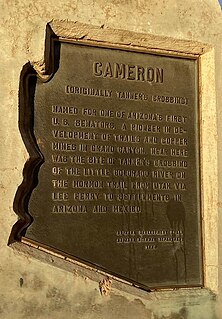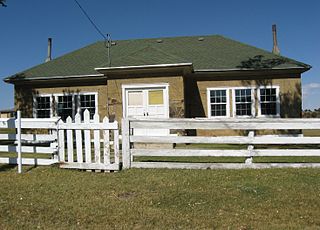
Cameron is a census-designated place (CDP) in Coconino County, Arizona, United States, on the Navajo Nation. The population was 885 at the 2010 census. Most of the town's economy is tourist food and craft stalls, restaurants, and other services for north–south traffic from Flagstaff and Page. There is a ranger station supplying information and hiking permits for the Navajo Nation as well as a small selection of books for sale. There is also a large craft store run by the Nation itself; most vendors in the area operate from small private stalls. It is named after Ralph H. Cameron, Arizona's first senator.

Iosepa is a ghost town in the Skull Valley, located approximately 75 miles (120 km) southwest of Salt Lake City in Tooele County, Utah, United States. Once home to over 200 Polynesian members of The Church of Jesus Christ of Latter-day Saints, Iosepa was inhabited during the period 1889–1917. Today, it is the site of an annual Memorial Day gathering that draws islanders and others from all over the Western United States.

Old Las Vegas Mormon Fort State Historic Park is a state park of Nevada, containing the Old Mormon Fort, the first structure built by people of European heritage in what would become Las Vegas fifty years later. In present-day Las Vegas, the site is at the southeast corner of Las Vegas Boulevard and Washington Avenue, less than one mile north of the downtown area and Fremont Street. This is the only U.S. state park located in a city that houses the first building ever built in that city. The fort was listed on the National Register of Historic Places on February 1, 1972. The site is memorialized with a tablet erected by The Church of Jesus Christ of Latter-day Saints in 1997, along with Nevada Historical Marker #35, and two markers placed by the Daughters of Utah Pioneers.

Kyle Ranch or Kiel Ranch, was one of the earliest ranches established in Nevada's Las Vegas Valley. Founded by Conrad Kiel in 1875, today the location of the former ranch is in North Las Vegas, where the city maintains the remnants of the site as the "Kiel Ranch Historic Park." The original adobe structure, one of the oldest buildings in Las Vegas, a wooden shed known as the "Doll House," and the cemetery are all that remain after loss of buildings through fire and neglect. Also within the park is an artesian well and a small wetlands, a reminder of what drew travelers and early settlers to the area. Presently the ranch's location is memorialized with Nevada Historical Marker number 224.

The Lee's Ferry and Lonely Dell Ranch Historic District includes the ranch homesteaded by Mormon pioneer John D. Lee at Lees Ferry, Arizona, and now in Glen Canyon National Recreation Area. It is notable for its association with Lee, the ferry and the ranch's extensive irrigation facilities. The district was originally designated the Lonely Dell Ranch Historic District on the National Register of Historic Places in 1978, but was expanded to include Lee's Ferry in 1997.
Chesterfield is a ghost town in Caribou County, Idaho, United States. It is located in Gem Valley at an elevation of 5,446 feet (1,660 m). The community includes a cemetery and former buildings of The Church of Jesus Christ of Latter-day Saints such as a former meeting house, amusement hall and tithing house.

Brigham City is a ghost town in Navajo County, Arizona, United States. Founded by member of The Church of Jesus Christ of Latter-day Saints near the present city of Winslow in 1876, it was one and one-half miles north of Winslow's current city center, along the Little Colorado River. It was organized as a Latter-Day Saints ward in 1878, but by 1881 it had been abandoned.

Grover is an unincorporated community in southwestern Wayne County, Utah, United States. Originally known as Carcass Creek, Grover is a small ranching community off the county's main recreational corridor.

The Old Settlers' Association of Johnson County Cabins, also known as City Park Cabins, are historic buildings located in Iowa City, Iowa, United States. These are two log structures built by the Old Settlers' Association of Johnson County. The single-room log cabin was built in 1889 for Johnson County's semicentennial. It had been located at two different county fairground sites until it was moved to City Park in 1918. The second cabin was built here by the association in 1913. It is a dogtrot house that is meant to be a replica of an early trading post in this area. These are typical log house forms from Iowa's pioneer era whose existence are now rare. They also represent an effort by a social organization to commemorate the community's common pioneer heritage. A third element that is part of the historical designation is a bronze plaque affixed to a granite boulder. Located southwest of the cabins, it was installed in 1929 to mark a "Grand Army Tree" that was planted nearby. It is not known if the tree survives. The buildings and plaque were listed together on the National Register of Historic Places in 2013.

Eagar Townsite Historic District is a section of the town of Eagar, Arizona which has been designated a National Historic Place. Sitting on roughly 54 acres, the site contains 37 structures, 21 of which have historical significance. The period of significance is from 1886, the year the townsite was founded, through 1942, which represents the significant period of development of the town. The site was added to the Register on July 23, 1993.

The Tuba Trading Post, in Tuba City, Arizona, is a building complex which was started in 1891 by trader Charles H. Algert as a two-room shed built of native limestone. It is a mostly stone building made up of segments of different styles. It was listed on the National Register of Historic Places in 1996.











